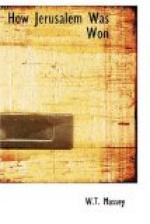and
Amphis, and the destroyers
Staunch
and
Comet, was worthy of the King’s Navy.
They were assisted by the French battleship
Requin.
We lost a monitor and destroyer torpedoed by a submarine,
but the marks of the Navy’s hard hitting were
on and about Gaza, and we heard, if we could not see,
the best the ships were doing. On one day there
was a number of explosions about Deir Sineid indicating
the destruction of some of the enemy’s reserve
of ammunition, and while the Turks were still in Gaza
they received a shock resembling nothing more than
an earthquake. One of the ships—the
Raglan, I believe—taking a signal
from a seaplane, got a direct hit on an ammunition
train at Beit Hanun, the railway terminus north of
Gaza. The whole train went up and its load was
scattered in fragments over an area of several hundred
square yards, an extraordinary scene of wreckage of
torn and twisted railway material and destroyed ammunition
presenting itself to us when we got on the spot on
November 7. There was another very fine example
of the Navy’s indirect fire a short distance
northward of this railway station. A stone road
bridge had been built over the wadi Hesi and it had
to carry all heavy traffic, the banks of the wadi
being too steep and broken to permit wheels passing
down them as they stood. During our advance the
engineers had to build ramps here. A warship,
taking its line from an aeroplane, fired at the bridge
from a range of 14,000 yards, got two direct hits
on it and holed it in the centre, and there must have
been thirty or forty shell craters within a radius
of fifty yards. The confounding of the Turks
was ably assisted by the Navy.
CHAPTER IX
CRUSHING THE TURKISH LEFT
Now we return to the operations of XXth Corps and
Desert Mounted Corps on our right. After the
capture of Beersheba this force was preparing to attack
the left of the Turkish main line about Hareira and
Sheria, the capture of which would enable the fine
force of cavalry to get to Nejile and gain an excellent
water supply, to advance to the neighbourhood of Huj
and so reach the plain and threaten the enemy’s
line in rear, and to fall on his line of retreat.
It was proposed to make the attack on the Kauwukah
and Rushdi systems at Hareira on November 4, but the
water available at Beersheba had not been equal to
the demands made upon it and was petering out, and
mounted troops protecting the right flank of XXth
Corps had to be relieved every twenty-four hours.
The men also suffered a good deal from thirst.
The weather was unusually hot for this period of the
year, and the dust churned up by traffic was as irritating
as when the khamseen wind blew. The two days’
delay meant much in favour of the enemy, who was enabled
to move his troops as he desired, but it also permitted
our infantry to get some rest after their long marches,
and supplies were brought nearer the front. ‘Rest’
was only a comparative term. Brigades were on
the move each day in country which was one continual
rise and fall, with stony beds of wadis to check progress,
without a tree to lend a few moments’ grateful
relief from a burning sun, and nothing but the rare
sight of a squalid native hut to relieve the monotony
of a sun-dried desolate land.




